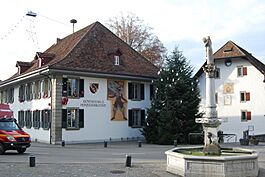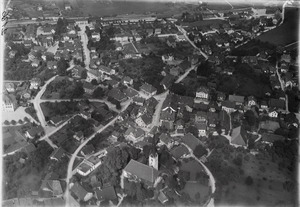Herzogenbuchsee facts for kids
Quick facts for kids
Herzogenbuchsee
|
||
|---|---|---|

Herzogenbuchsee town center
|
||
|
||
| Country | Switzerland | |
| Canton | Bern | |
| District | Oberaargau | |
| Area | ||
| • Total | 9.82 km2 (3.79 sq mi) | |
| Elevation | 458 m (1,503 ft) | |
| Population
(Dec 2020 )
|
||
| • Total | 7,293 | |
| • Density | 742.7/km2 (1,923.5/sq mi) | |
| Postal code |
3360
|
|
| Surrounded by | Bettenhausen, Graben, Heimenhausen, Niederönz, Oberönz, Thörigen, Thunstetten, Wanzwil | |
| Twin towns | Senica (Slovakia) | |
Herzogenbuchsee is a town in Switzerland. It is located in the canton of Bern. This town is part of the Oberaargau administrative district. In 2011, about 7,055 people lived here. Its old name was Buchsi.
Contents
History of Herzogenbuchsee
Herzogenbuchsee is built on a moraine. A moraine is a pile of rocks and dirt left behind by a glacier. People have lived in this area for at least 10,000 years. Ancient settlements were found near the Inkwilersee and Burgäschisee lakes. There is also proof of Roman buildings. These buildings were from around 200 CE. They were found near the current Reformed Church.
The name puhsa was first used in 886 CE. This name means "box" (like the plant). In 1220, the town was called Buchse. To tell it apart from another town, Münchenbuchsee, it was called Herzogenbuchze in 1301.
Over time, different groups ruled the town. These included Burgundy and the Zähringer family. Later, the Kyburger family took over. Finally, the town came under the rule of Altberni.
On January 1, 2008, the town of Oberönz joined Herzogenbuchsee. This made Herzogenbuchsee bigger.
Geography of Herzogenbuchsee
Before Oberönz joined, Herzogenbuchsee was about 6.8 square kilometers (2.6 square miles). About 35.1% of this land was used for farming. Forests covered 35% of the area. The rest, about 29.9%, was used for buildings and roads.
After the towns merged in 2009, Herzogenbuchsee became 9.83 square kilometers (3.79 square miles). Now, about 37.6% of the land is for farming. Forests cover 34.4% of the area. Buildings and roads take up 27.1% of the land. A small part, 0.2%, is rivers or lakes. The train station in Herzogenbuchsee is 465 meters (1,526 feet) above sea level.
Coat of Arms
The town's coat of arms has a special design. It shows a red background. Across the middle is a silver band. On this band are six green box leaves. At the top, there is a golden crown.
Population and People
Herzogenbuchsee has a population of 7,293 people. As of 2007, 1,036 people living there were from other countries. Over the past 10 years, the population has grown by 6.1%.
Most people in Herzogenbuchsee speak German. About 88.9% of the population speaks German. Italian is the second most common language, spoken by 3.5%. Albanian is third, spoken by 2.6%.
In 2000, children and teenagers (0–19 years old) made up 22% of the population. Adults (20–64 years old) were 59.6% of the population. Seniors (over 64 years old) made up 18.4%. About 71.2% of adults (aged 25–64) have finished high school or gone to college.
Herzogenbuchsee has a low unemployment rate of 1.88%. This means most people who want to work have jobs. In 2005, 31 people worked in farming. There were 9 businesses in this area. Many people, 1,344, worked in manufacturing and industry. There were 78 businesses in this field. The largest number of people, 1,931, worked in services. This includes shops, hospitals, and schools. There were 249 businesses in the service sector.
Here is how the population has changed over time:
| year | population |
|---|---|
| 1764 | 481 |
| 1850 | 1,525 |
| 1900 | 2,533 |
| 1950 | 3,790 |
| 2000 | 5,338 |
Transportation
Herzogenbuchsee has its own railway station. It is called Herzogenbuchsee. This station is on the Olten–Bern railway line. Trains from here go regularly to big cities. You can travel to Zürich Hauptbahnhof, Bern, and Olten.
Notable People
- Pierre du Bois de Dunilac (1943–2007): He was a writer and political scientist. He was born in Herzogenbuchsee.
- Simon Berger (born 1976): He is a modern artist from Switzerland.
Images for kids
See also
 In Spanish: Herzogenbuchsee para niños
In Spanish: Herzogenbuchsee para niños







